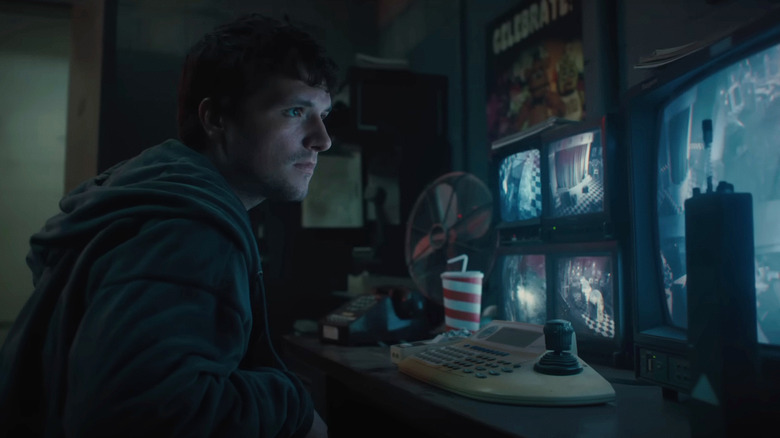From being a popular indie game to becoming a newly adapted movie, “Five Nights at Freddy’s” (FNAF) lives as a masterful story from the mind of Scott Cawthon. Released on Oct. 27, the film welcomed Halloweekend with a video game-inspired spectacle filled with familiar faces and rich history. As the film’s title sequence begins, digital scenes play out the most basic lore, just as it does within the game. The arcade-themed pixels present new viewers with a mysterious backstory and mark the beginning of almost two hours of nostalgia for
familiar fans and players.
“Five Nights at Freddy’s” follows Mike (Josh Hutcherson, “Hunger Games”), a young man struggles to support raising his younger sister Abby (Piper Rubio). Desperate for a job, Max accepts an offer from Steve Raglan, portrayed by horror icon Matthew Lillard (“Scream” and “Scooby-Doo”), to work as a nighttime security guard at Freddy Fazbear’s Pizzeria. After run-ins with Vanessa, a mysterious security guard played by Elizabeth Lail, known to thriller fans as Beck from “You,” and the lively animatronics Freddy, Chica, Foxy and Bonnie, Mike must unravel the mystery of his brother’s kidnapping while keeping his sister safe.
The realization of this narrative worked but did not exceed expectations. Vanessa’s introduction felt hurried, along with the answer to the question of Mike’s brother’s disappearance, which did not track when logistically analyzed by game fans. For audience members familiar with the multitude of game lore, the reveals were anticipated yet well-received. The appearance of Golden Freddy, especially the specificity of his blue-lit eye, reflected well on the dedication the script had to the game series.
Major YouTube game theorist MatPat, who helped catapult the popularity of “Five Nights at Freddy’s,” also made a cameo in the film as a waiter. Other details turned the film into an enjoyable adventure for those familiar with the game. The inclusion of the Circus Baby animatronic with the character destined to have a close relationship with it, the concept of shocking the animatronics to survive and the full name of the protagonist “Mike Schmidt,” who shares the same name as the player in the “Five Nights at Freddy’s” games, were all nostalgic to fans.
“Five Nights at Freddy’s” received conflicting results across critic and audience scores. From a purely cinematic standpoint, the film is no gem. However, for diehard fans of the game or just avid followers of the lore, the film succeeds as an inviting, respectful adaptation. The narrative eases audiences into the background of Freddy Fazbear’s Pizzeria without rushing the process. Backstories of key characters, such as Vanessa and the five children in Mike’s dream, are revealed as the story progresses, even leaving some to unfold until the end.
Writers took an inventive approach to humanize the animatronics in this film. Rather than focusing on the animatronics and learning about their liveliness from other characters, the film communicates the pizzeria’s history and the source of animatronic life through their childlike spirits.
These dream sequences were some of the best cinematic scenes within the film. Each dream furthered the narrative by giving a piece of the animatronic puzzle to Mike while juxtaposing the traditional low-key lighting of the rest of the film with high-key lighting. A common theory with “Five Nights at Freddy’s” fans is that everything is simply a dream. The “dream theory” appears early in the film and ties into the prevalence of Max’s own dreams each night in Freddy Fazbear’s Pizzeria.
The most uncomfortably satisfying scenes come from the villain’s reckoning. Just as players see in Five Nights at Freddy’s 3 video game, the filmmakers finally introduce the infamous Yellow Bunny from the opening sequence. Characters unravel and standoffs play out, all while sticking to the revelation within the third game. While there is minimal gore, the bodily squelching from broken spring traps paired with the pained movements from a certain someone as they meet their fate, all without showing the person on-screen, make for a
beautifully sick ending.
Despite the praise from game veterans, many aspects of the film prove far from enticing. Babysitter and betrayer Max’s entire storyline felt sloppy, as her character only provided an excuse to showcase the murderous tendencies of the animatronics. This important development for unfamiliar fans appeared downplayed and restrained from the savagery seen within the game.
Even with its horror designation, the movie’s lack of jump scares and minimal suspense outside of animatronics. If the film focused more on Mike having to survive the nights separate from the dream scenes proved a missed opportunity to build a thrilling narrative.
Audiences loved the commitment to “Five Nights at Freddy’s” source material but yearned for the same chilling suspense and heart- racing onslaught of animatronics. The few moments that excel at horror fall in Mike’s dreams when the audience cannot see the real storyline with his sister. The thrill of the game does not quite translate into the movie.
“Five Nights at Freddy’s” incorporates a combination of its game releases to build a narrative special to fans but inadequate to FNAF novices. While loyal to the lore, the execution of “horror” and cinematography fall flat, pushing the movie into the hearts of game veterans but out of favor with the rest.
If you love the games, lore or enjoy a delightfully twisted movie without needing strong visuals or a gripping thrill, take a chance and awaken the night by watching “Five Nights at Freddy’s.”
